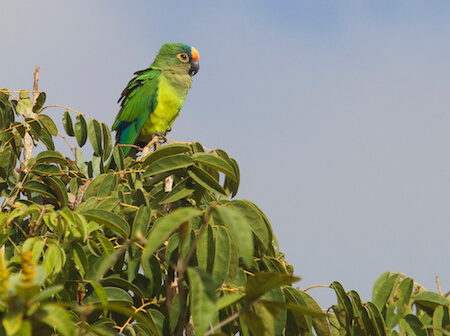Main menu
CEPF is a joint initiative of l’Agence Française de Développement, Conservation International, the European Union, Fondation Hans Wilsdorf, the Global Environment Facility, the Government of Japan and the World Bank.
Visitez le site français コア情報の日本語翻訳を読むOr use Google Translate to translate the English site to your language:
GTranslate
The Ignored Crisis in Brazil
Most people haven't heard of the Cerrado, and that's a problem
By: Marsea Nelson, CEPF senior communications manager
08 April 2020
08 April 2020
Portuguese translation available on the IEB website.
For months, the fires plaguing the Amazon made front-page headlines across the globe, and with good reason. The iconic rainforest stores millions of tons of carbon dioxide—its burning means a less stable climate across Earth.
Fires also devasted another part of South America, but coverage of this catastrophe was scant.
In the center of Brazil (plus small portions of Bolivia and Paraguay) lies 200 million hectares of tropical savannah known as the Cerrado. The first settlers in the Cerrado considered it a barren wasteland, but that couldn’t be further from the truth. This region is considered the most biodiverse tropical savanna on Earth, holding 5 percent of the world’s species. And, like the Amazon, the Cerrado holds a critically important amount of carbon.
The misunderstanding of the Cerrado’s importance is perhaps, in part, due to where its carbon is stored. The Cerrado’s savanna experiences a long dry season each year; trees and plants have adapted by growing down instead of up. As much as 70 percent of the Cerrado’s biomass is underground.
“For most Brazilians the Cerrado is the ‘ugly’ forest, since it has a long dry season and most of the trees don't grow tall, as in the Amazon,” said CEPF Regional Implementation Team Leader Michael Becker. “One has also to consider that the dimensions of the Cerrado are very difficult to grasp. Considering a north south axis, it spreads further than the distance between Chicago and Monterrey, Mexico, and has many differences landscapes.”
Living within the Cerrado’s varied ecosystems are some 5 million people, namely indigenous peoples, traditional communities and family farms. They rely on the region’s natural resources for their livelihoods. The biodiversity hotspot’s importance isn’t restricted to its borders, however. Rivers and rains within the Cerrado are connected to almost all of Brazil—assisting with agriculture, hydropower and human water consumption.
The second largest underground reservoir of water in the world—the Guarani Aquifer—as well as the largest wetland in the world—the Pantanal—depend on water flowing from the Cerrado.
Knowing all this, it’s alarming to learn that the Cerrado’s destruction is already well under way: About 50 percent of the hotspot has been deforested—primarily for large-scale agriculture—and a large portion of what is left has had some sort of interference. All this before the recent fires swept through the region.
There are, however, positive steps being taken to protect this critically important place:
- Brazil’s flourishing coffee industry was taking a harsh toll on the hotspot, so CEPF grantee Instituto de Manejo e Certificação Florestal e Agrícola (IMAFLORA) co-founded the Cerrado Waters Consortium to make coffee production more sustainable. A payment for ecosystem services (PES) scheme is underway in the municipality of Patrocínio, with plans for replication in other parts of the Cerrado if it’s successful.
- The buriti tree is found in abundance in the Cerrado and has serious revenue-generating potential. It can be overexploited, though, so CEPF grantee Cooperativa dos Agricultores Familiares e Agroextrativistas Grande Sertão (CGS) is training farmers in sustainable harvesting practices and efficient processing techniques. So far, more than 400 people have received training and income paid to farmers has increased.
- The beta version of the Cerrado Knowledge online platform recently went live. Created by Fundação de Apoio a Pesquisa - Funape and Image Processing and Geoprocessing Laboratory (LAPIG), and funded by CEPF, the platform consolidates geospatial and census knowledge about the region, arming conservationists and the government with crucial data to help them make well-informed decisions.
- With help from a CEPF grant, the Kalunga—an isolated community of descendant of runaway slaves—is using technology to map the area where they live, better enabling them to defend their land and traditional way of life.
- CEPF grantee Funatura is working to establish 50 private natural heritage reserves in the Cerrado through several approaches, including showing landowners the untapped potential of ecotourism.
Efforts like these are encouraging, but the road to a healthy, thriving Cerrado will be long.
“With half of the Cerrado still preserved, this hotspot could be an excellent case study proving that conservation, people’s rights, and agricultural production can co-exist and share nature’s benefits,” Becker said. “CEPF is working towards that goal.”
Learn more about CEPF’s investment in the Cerrado Biodiversity Hotspot.








